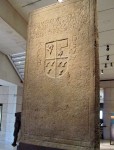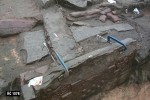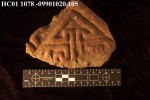 The National Museums Scotland will be enlisting the aid of gamers to help piece back together the base of the Hilton of Cadboll Stone, an elaborately carved Pictish sandstone cross-slab from 800 A.D. The stone once stood in Hilton of Cadboll, a seaboard village on the east coast of the Tarbat Peninsula in northeastern Scotland. Originally carved on the seaward side with an early Christian cross and on the landward side with traditional Pictish symbols like the crescent and double disc and secular themes like a hunting scene, the stone was knocked down in the 17th century, possibly by a storm in 1674.
The National Museums Scotland will be enlisting the aid of gamers to help piece back together the base of the Hilton of Cadboll Stone, an elaborately carved Pictish sandstone cross-slab from 800 A.D. The stone once stood in Hilton of Cadboll, a seaboard village on the east coast of the Tarbat Peninsula in northeastern Scotland. Originally carved on the seaward side with an early Christian cross and on the landward side with traditional Pictish symbols like the crescent and double disc and secular themes like a hunting scene, the stone was knocked down in the 17th century, possibly by a storm in 1674.
 After its fall, it was lying face down with the Christian side exposed which apparently gave someone a very bad idea. One Alexander Duf had the early Christian Pictish cross on the reverse side chipped away and replaced with his crappy coat of arms. He also left an inscription identifying himself as the vandal: “He that believes well does well sayeth Solomon the wyse. Heir lyes Alexander Duf and his three wyves 1676.”
After its fall, it was lying face down with the Christian side exposed which apparently gave someone a very bad idea. One Alexander Duf had the early Christian Pictish cross on the reverse side chipped away and replaced with his crappy coat of arms. He also left an inscription identifying himself as the vandal: “He that believes well does well sayeth Solomon the wyse. Heir lyes Alexander Duf and his three wyves 1676.”
The criminal carving was done, but the stone was not moved to Mr. Duf’s actual tomb. It remained where it fell until the mid-19th century when the MacLeods of Cadboll removed it to Invergordon Castle for use as a garden ornament. From there it spent a brief stint in the British Museum in 1921, but public opinion was strongly opposed to the move, so it came back to Scotland within the year, this time going to the National Museum of Scotland in Edinburgh where it is still on display today in the Early People gallery.
 In 2001, Historic Scotland funded an excavation by the Glasgow University Archaeological Research Division (GUARD) on the site where the cross-slab had stood for eight centuries. Their aim to recover any fragments of the stone left behind and to determine when it was first erected. They found the missing base of the slab and more than 3,000 fragments of the carved cross face chiseled away to make way for Mr. Duf’s execrably poor taste and narcissism. The pieces range in size from little chips three centimeters (1.18 inches) in diameter to large pieces as much as 20 centimeters (7.87 inches) long.
In 2001, Historic Scotland funded an excavation by the Glasgow University Archaeological Research Division (GUARD) on the site where the cross-slab had stood for eight centuries. Their aim to recover any fragments of the stone left behind and to determine when it was first erected. They found the missing base of the slab and more than 3,000 fragments of the carved cross face chiseled away to make way for Mr. Duf’s execrably poor taste and narcissism. The pieces range in size from little chips three centimeters (1.18 inches) in diameter to large pieces as much as 20 centimeters (7.87 inches) long.
 Putting humpty dumpty back together has proved to be too challenging with conventional methods, and it has taken more than a decade for a possible technology solution to be developed. Scottish technology firm Relicarte has developed a program which gives users access to 3D scans of each fragment which can then be pieces together in an online 3D environment.
Putting humpty dumpty back together has proved to be too challenging with conventional methods, and it has taken more than a decade for a possible technology solution to be developed. Scottish technology firm Relicarte has developed a program which gives users access to 3D scans of each fragment which can then be pieces together in an online 3D environment.
Aegir Maciver, director of Peebles-based Relicarte, which developed the platform for online gamers, said the stone’s precious fragments were transported at night to Borders General Hospital, placed in trays and put through a CT scanner, which digitised the fragments and reproduced them as 3D objects.
The task, which took two nights to complete, also involved the laborious business of labelling each individual fragment.
“We had already been doing some work at the museum and we were told they were about to undertake the Cadboll Stone project and intended to have a digital aspect too and asked us to come up with ideas,” Maciver said.
“We came up with the crowd-sourcing idea and digitising the three and a half thousand fragments. We created an online software platform which allows you to view and manipulate files.”
Maciver continued: “It’s very innovative and allows people who don’t have powerful computers or 3D software to go online and interact with 3D models in real time.”
Because gamers are accustomed to manipulating objects in a virtual 3D environment, archaeologists hope to enlist their skills in solving the puzzle of the Hilton of Cadboll fragments. National Museums Scotland will shortly issue an appeal to gamers asking them to contribute to the herculean effort of piecing together the carvings which can then be deciphered by experts in Pictish symbology.
UPDATE 10/10/2013: And we have a website! It’s just a placeholder right now. Pictish Puzzle officially launches on October 25th.
I’m always amazed when something you never thought even existed anymore,has a chance to be recreated. Like paintings under other paintings or the Antikythera Mechanism. I’m sure this will be done at warp speed.
😎 The best game yet! fitz